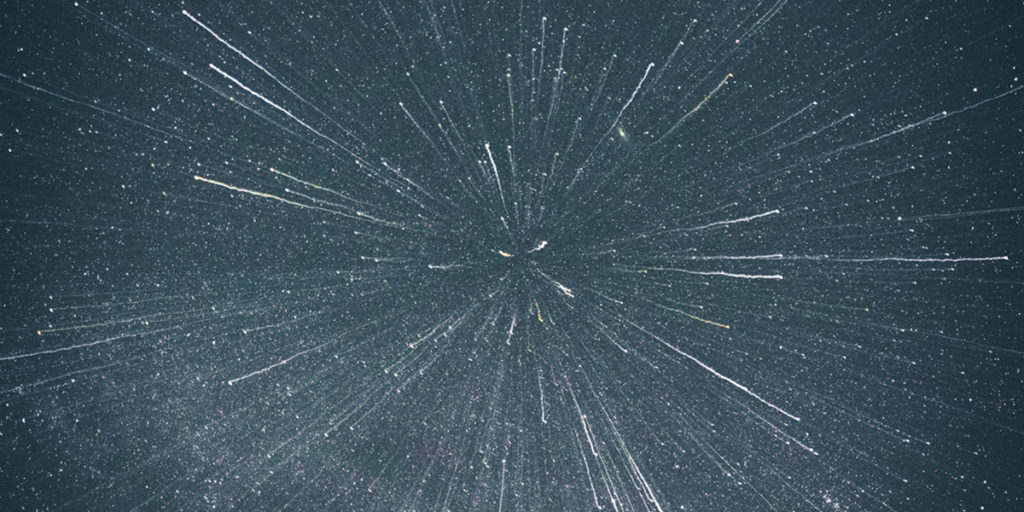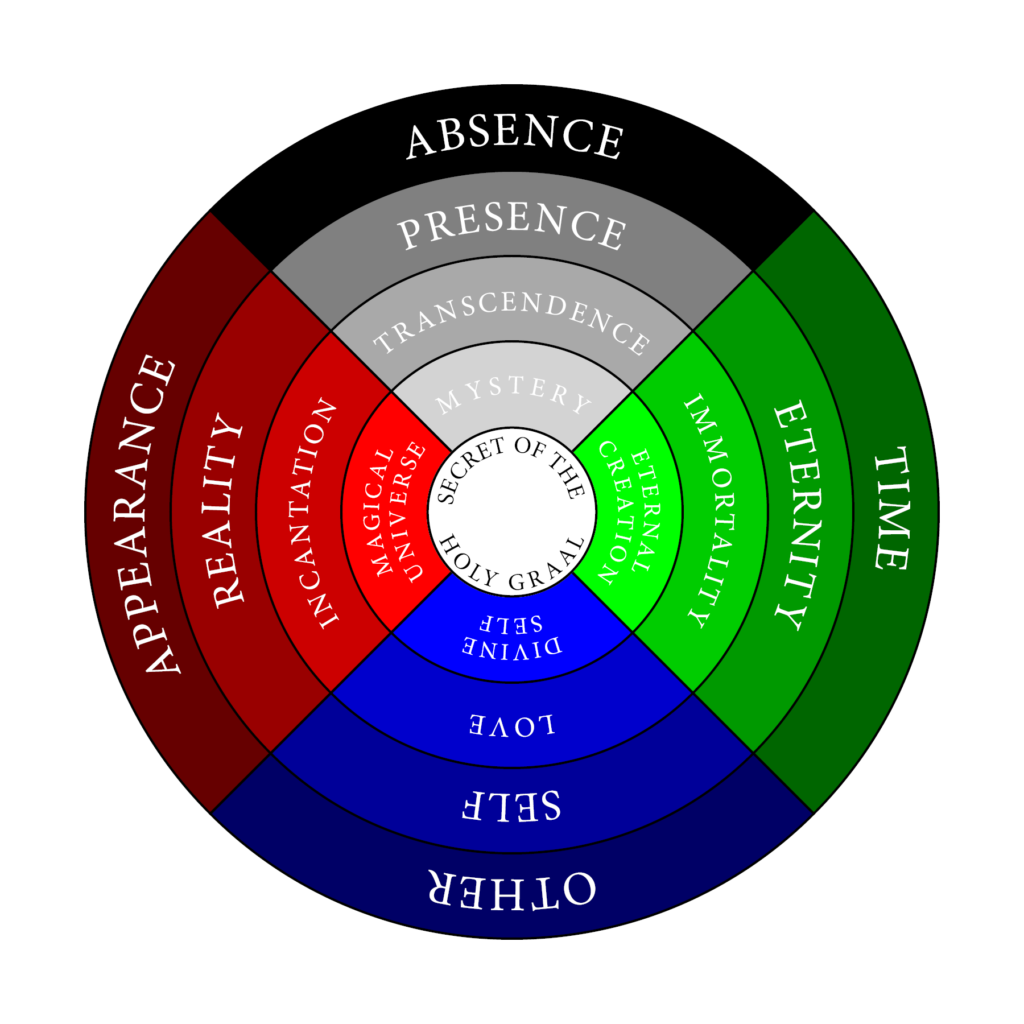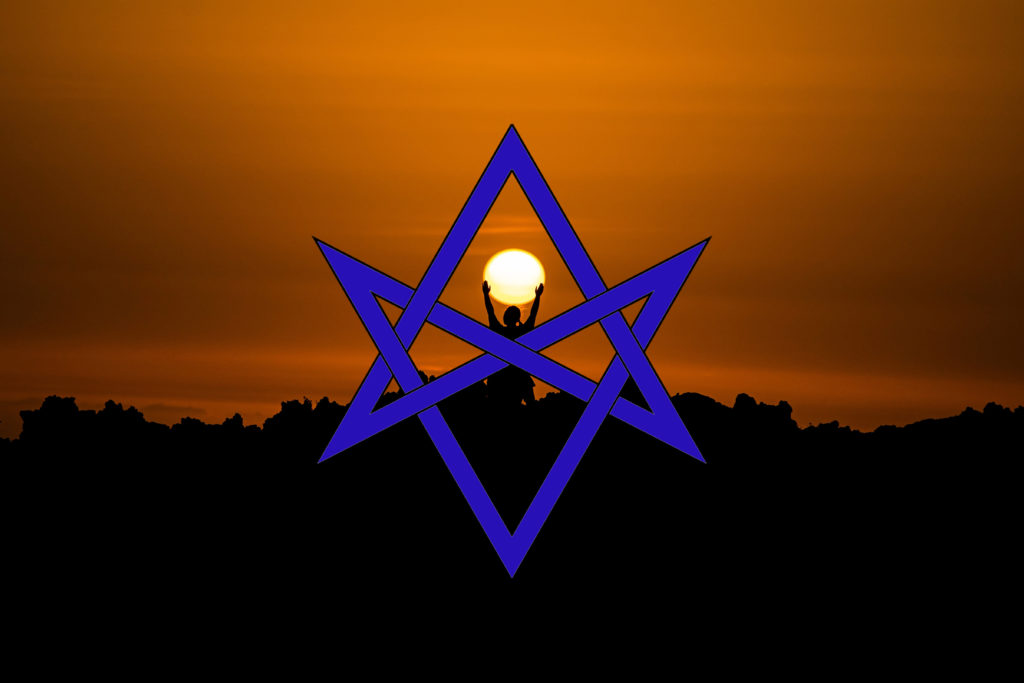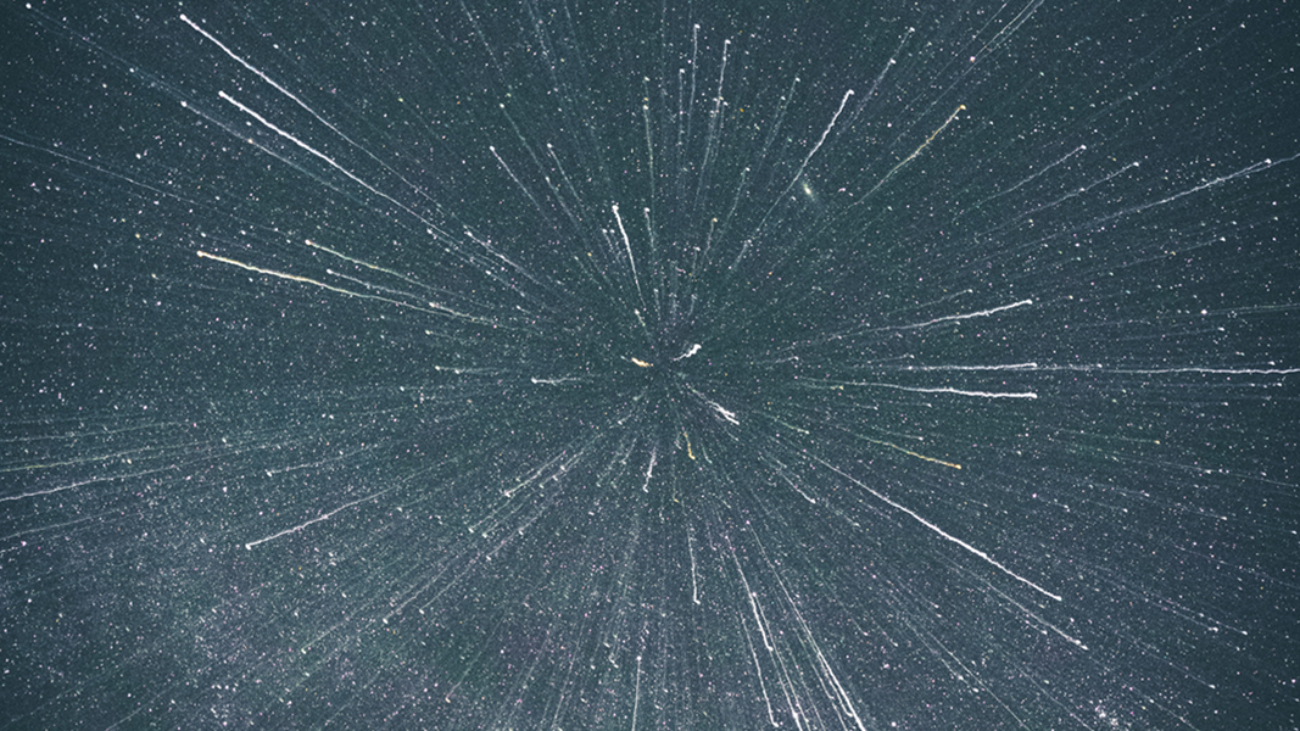The idea that truth—spiritual or otherwise—reduces to personal truth isn’t “Thelemic” per se. It’s just secularism. That’s one of the defining stroke of the secularist worldview.
Self-Transcendence

As mentioned previously, Crowley’s philosophy can be understood as a form of derivation monism: the requirement that the a priori conditions of experience must be somehow derived from a single, absolute first principle. For Crowley, the a priori conditions of experience are the subjective point of view (which he calls Hadit) and the intersubjectively accessible spatiotemporal universe (which he calls Nuit). The single, absolute first principle grounding these conditions he calls Qabalistic Zero or nothingness extended in no categories.
Additionally, Crowley can also be understood as being committed to a modified version of derivation monism called holistic monism. Holistic monism may be divided into two requirements. The holistic requirement is that empirical items must be such that all their properties are determinable only within the context of a totality composed of other items and their properties. As Crowley says, all of our empirical knowledge is “relative” or conditioned—or as Crowley sometimes puts it, “illusory”.
The monistic requirement is that the absolute first principle must be immanent within the aforementioned totality as its principle of unity. Crowley expresses this a number of ways. All manifestation (or what Crowley calls duality) “cancels out” or “balances”. The universe is apparently in ceaseless motion, and yet this motion adds to 0 or stillness. Hence, manifestions is identical with nullity, or 0 = 2.
Holistic monism can be viewed as a response to a problem originating in Platonic metaphysics, namely, how the first principle relates to or “participates in” the items it grounds. In order for the first principle to serve as ground, it must be divided up somehow into the things that it grounds. But then it loses its unity. But in order for it to maintain its unity, it has to transcend reality, and hence not have contact with it.
The holistic monist response to this problem is to maintain that the sum total of reality is one and is identical with the absolute first principle, but this does not mean that the first principle loses its transcendence, because reality itself is self-transcending. In other words, reality is constantly canceling or negating itself.
To put it another way, what the Neoplatonists said of the One—that it is self-transcending—holistic monists say of the sum total of reality itself. Reality must not be understood as an inert, static, unmoved substance but rather something more like a living being that is constantly producing itself through self-cancellation.
To model one’s individual life on the basis of nature, therefore, means to be in a state of continually overcoming one’s own sense of self, or more exactly, the sense that one has of being a separate, static substance standing apart from the rest of reality. This isn’t done through the denial of self, as in ascetic spiritual practice, but rather through the expansion of one’s sense of self through the affirmation and acceptance of more and more of the universe.
The Adept must accept every “spirit”, every “spell”, every “scourge”, as part of his environment, and make them all “subject to” himself; that is, consider them as contributory causes of himself. They have made him what he is. They correspond exactly to his own faculties. They are all – ultimately – of equal importance. The fact that he is what he is proves that each item is equilibrated. The impact of each new impression affects the entire system in due measure. He must therefore realize that every event is subject to him. It occurs because he had need of it. Iron rusts because the molecules demand oxygen for the satisfaction of their tendencies. They do not crave hydrogen; therefore combination with that gas is an event which does not happen. All experiences contribute to make us complete in ourselves. We feel ourselves subject to them so long as we fail to recognise this; when we do, we perceive that they are subject to us. And whenever we strive to evade an experience, whatever it may be, we thereby do wrong to ourselves. We thwart our own tendencies. To live is to change; and to oppose change is to revolt against the law which we have enacted to govern our lives. To resent destiny is thus to abdicate our sovereignty, and to invoke death. Indeed, we have decreed the doom of death for every breach of the law of Life. And every failure to incorporate any impression starves that particular faculty which stood in need of it.
Liber Samekh
From a macrocosmic point of view, the universe is “nothing” through and through. What we call “reality” is purely relative and illusory, and anything we say of it is, at best, only provisionally true. This reality does have an ultimate cause or first principle, but that principle is also nothing (the Qabalistic Zero). Both the self as experiencer and the object as experienced are particularizations or self-limitations of nothingness. The metaphysics is nihilistic through and through.
However, the self is a negative actuality expressed against the negativity of (apparent) reality. It expresses its negativity through the destruction of difference between itself and those things around it. Hadit unites continually and endlessly with Nuit. He is never substantial or separate—never a being possessed of a will but rather willing itself—always only ever overcoming the difference between himself and Nuit. This continual annulment of distinction Crowley calls love. It is a destruction, cancellation, negation, or overcoming which is productive of union.
The main mode of operation of the will is negative. It annuls distinction. But to annul distinction is to produce or to create something new, i.e., every “fresh new experience”. The nihilism or nothingness of reality is the condition of operation of the will. It allows the will to be unrestricted by any external being, and it sets the stage for the cancellation of nothingness, a negation of negation which produces a positive, affirmative reality.
Therefore the nihilistic metaphysics of the world can be viewed as the negative image from which an affirmative, positive view of reality can be constructed, i.e., willed. At the center of this positive, inverted image of the macrocosm is the magician who creates by destroying distinction between his or herself and the universe. The main method by which distinction is destroyed is through the unconditional, absolute acceptance of what is, as it is, or what I have elsewhere referred to as erotic destruction or erotic liberation.
The Secret of the Holy Graal

Not sure if I ever offered an explanation of my intention in making this.
This was meant to visualize some insights I had while listening to Alan Chapman’s Magia Teachings and reading Peter Kingsley’s book on Carl Jung, Catafalque, last summer.
The outer circle represents forms of absence. The flow of time is the absence of presence or the now. The other is the absence of self or self-subsistence. Appearance is the absence of reality.
Opposed to absence is the second circle of presence. Eternity is opposed to time by standing outside of it. It is the eternal present or the eternal now. Self is opposed to other. It is that which subsists, that which possesses itself. Reality is opposed to mere appearance by being the opposite of illusion.
Philosophy and spirituality aim to overcome absence and to achieve presence. They aim at timeless truth, the One Self or One Itself, the reality that lies behind the mere flow of appearances.
But overcoming absence is merely the first stage of the process. The next level of insight requires one to find absence in presence: eternity in the here and now, self in other and other in self, reality in appearance. Once both presence and absence are found in one another, their duality is transcended.
The union of time and eternity is immortality.
The union of self and other is love.
The union of appearance and reality is incantation or magical speech.
Aleister Crowley grasps this non-duality of duality and non-duality through the idea of 0=2. But 0=2 is not the mystery itself but rather the gateway to the mystery. 0=2 is the portal through which Thelemic spirituality opens on to the subterranean current of mystery underlying human transcendence as such.
Now we encounter eternal creation as the characteristic activity of the immortal God.
We find the divine self as the the loving comportment of All with Itself.
And we find the magical universe as the self-speaking totality.
Beyond even that mystery there is the mixing bowl or kratēr in which All is manifest: the divine individual, the sōtēr or the Holy Graal.
Another reason to practice Liber Resh

In the Platonic tradition, the Sun is a symbol of unity. It is the visible and sensible analog of the One Itself which gives unity in the purely intelligible realm. This One Itself transcends being and non-being. In fact it transcends all opposition whatsoever and is the sole cause of anything being whatever it is. For this reason it is also called the Good Itself.
The equivalent of the One in Thelema is Kether, which is also associated with Ra-Hoor-Khuit. Speaking in the 1st Aethyr of The Vision and the Voice, Ra-Hoor-Khuit declares:
I am light, and I am night, and I am that which is beyond them.
I am speech, and I am silence, and I am that which is beyond them.
I am life, and I am death, and I am that which is beyond them.
I am war, and I am peace, and I am that which is beyond them.
I am weakness, and I am strength, and I am that which is beyond them.
Yet by none of these can man reach up to me. Yet by each of them must man reach up to me.
The unity of opposites represented by Ra-Hoor-Khuit transcends both our capacity of reasoning as well as our capacities of sensation or intuition. Nevertheless, the Sun serves as a visual analog of this transcendent principle, much as it did for the Platonists. Thus four times a day, Thelemites turn toward the Sun and cry aloud:
Unity uttermost showed!
It is necessary to put ourselves into contact with transcendent unity, because as conditioned beings, we do not contain unity within ourselves.
Everything that we are or could even know—about ourselves or about the world—falls into five “heaps” or khandhas. We know by means of sensible impressions (rupa); the pleasure, displeasure, or boredom arising from them (vedana); perceptions (samjna); habituated tendencies (sankhara); and consciousness (vijnana). Each of these arises and passes beyond our control. Insofar as any of these abide for awhile, they change constantly. Therefore they are unreliable, and none can be said to be a self, to contain a self, to be under the control of a self, or to be in a self. None can provide lasting happiness. Even consciousness comes and goes throughout the day, when we fall asleep, or when we die.
For this reason, Crowley declared that the principle of unity of each person—as represented by their spiritual Sun, their Holy Guardian Angel—could not be found by means of introspection.
Apart from any theoretical speculation, my Sammasiti and analytical work has never led to so much as a hint of the existence of the Guardian Angel. He is not to be found by any exploration of oneself.
Magick without Tears, Chapter 43
And yet achieving unity is the preeminent goal of Thelemic ethics.
A Man whose conscious will is at odds with his True Will is wasting his strength. He cannot hope to influence his environment efficiently.
(Illustration: When Civil War rages in a nation, it is in no condition to undertake the invasion of other countries. A man with cancer employs his nourishment alike to his own use and to that of the enemy which is part of himself. He soon fails to resist the pressure of his environment. In practical life, a man who is doing what his conscience tells him to be wrong will do it very clumsily. At first!)
Magick in Theory and Practice, Introduction
Therefore turning toward the Sun four times a day is not a mere religious observance. It serves an important spiritual and ethical purpose.
By turning toward the Sun, we first admit that unity is not automatically present within us. As far as we have come in life, we still have work to do on ourselves. The process is continual. We can always improve.
Second, we recognize that the principle of unity—hence the principle of self-subsistence and enduring happiness—transcends who we ordinarily take ourselves to be. We recognize that when we identify with the skandhas, we’re like a person trying to build a house on quicksand.
Thelemites sometimes talk about the difference between the small-s self, which we identify with our egos, versus the big-s Self, which we identify with Jechidah or the Holy Guardian Angel. In fact there is only one self to speak of, since what we call “self” (with the small-s) is merely an illusion. When we turn toward the Sun, we allow its radiance to dispel this illusion all together, so that our entire being can enjoy contact with that which truly deserves to be called self.
He is the Open Eye of the exalted Sun, before whom all shadows flee away: also that Secret Eye which makes an image of its God, the Light, and gives it power to utter oracles, enlightening the mind.
Magick in Theory and Practice, Chapter 5
I adore the might of Thy breath,
AL III.37
Supreme and terrible God,
Who makest the gods and death
To tremble before Thee—I, I adore thee!
And then finally, having recognized the true source of unity beyond becoming, beyond opposition, we learn to surrender ourselves to it. Gradually we come to see ourselves as instruments or extensions of it. The more frequently we reestablish conscious contact with this spiritual unity or Jechidah, the easier and more habitual it is for us to find that lifeline and source of spiritual power in difficult times. We learn to tolerate misfortune with equanimity, knowing that even in the darkest hour, a radiant god stands at our backs.
And should we follow that lifeline back to its source, any one of us can pass through that “secret door / Into the house of Ra and Tum, of Khephra and of Ahathoor” and attain to direct awareness of that “center and secret of the Sun” which Crowley himself knew in his most exalted visions.



